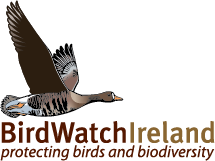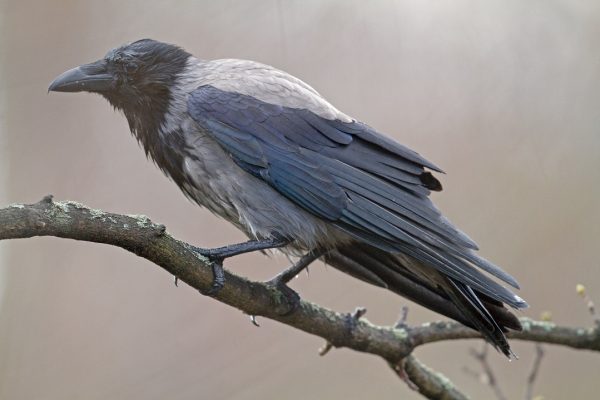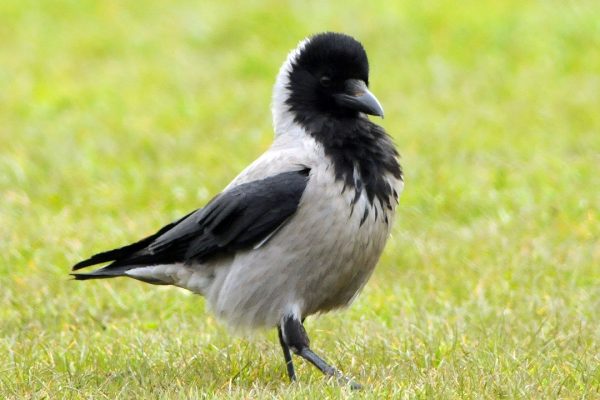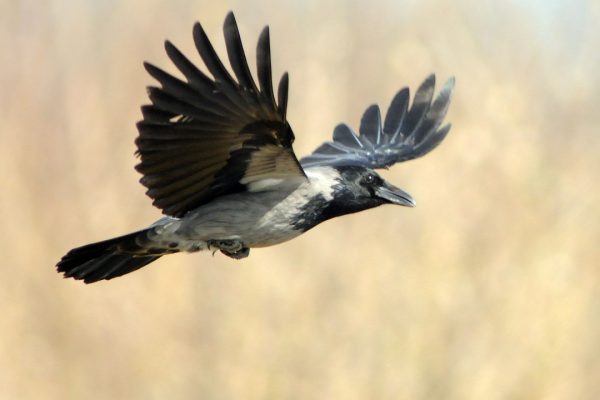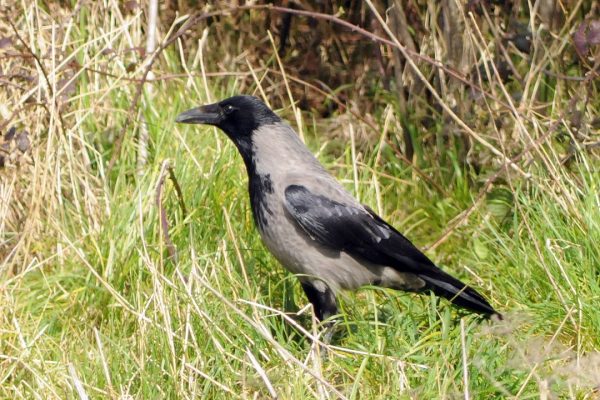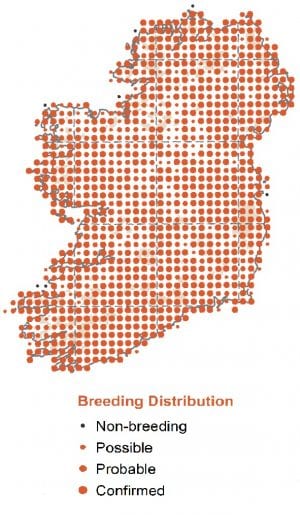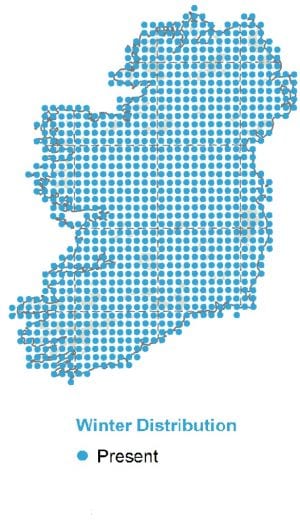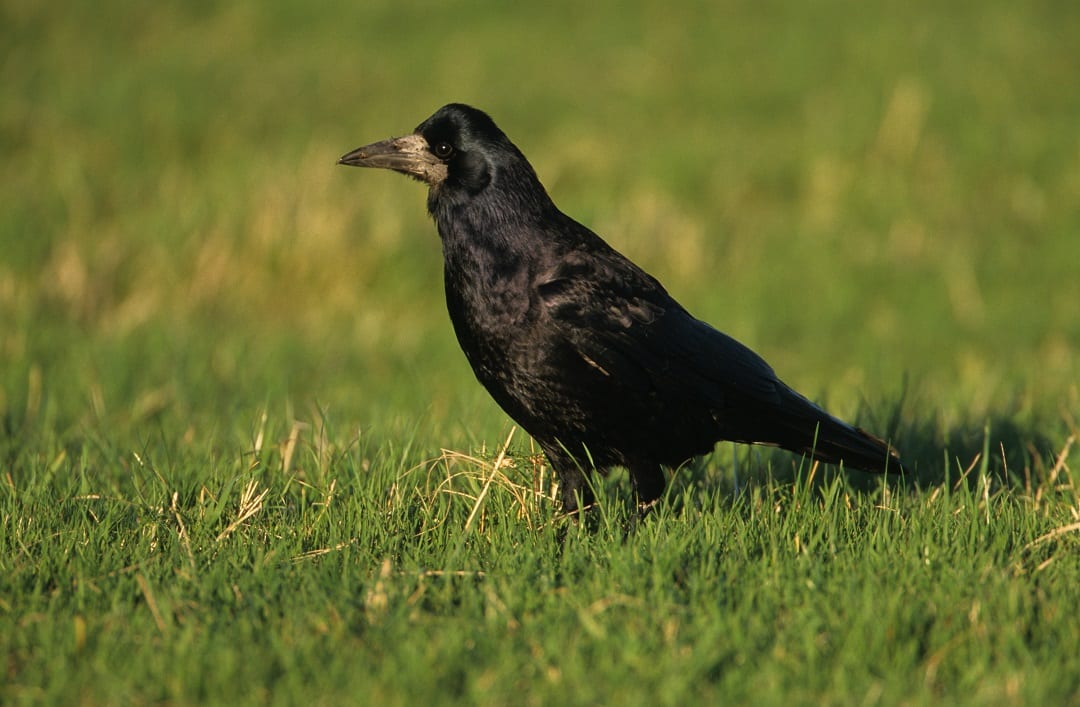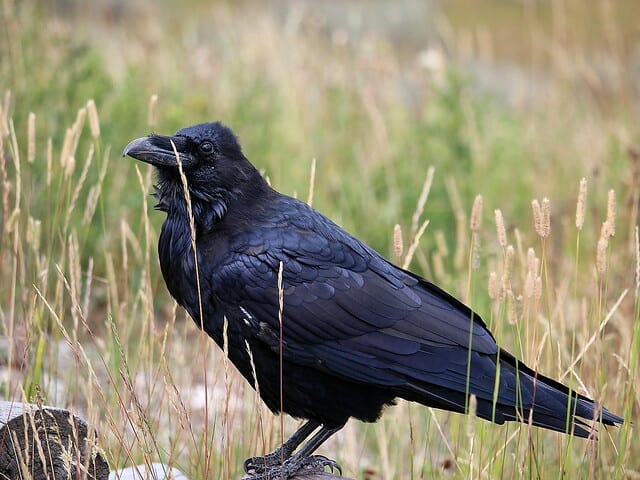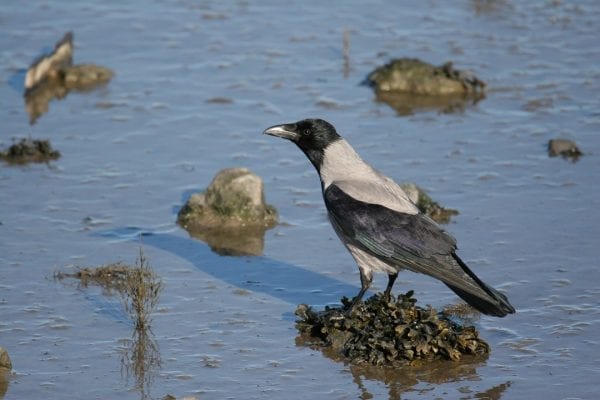
Hooded Crow
| Irish Name: | Caróg liath |
| Scientific name: | Corvus cornix |
| Bird Family: | Crows |
green
Conservation status
Conservation status
Status
Common resident throughout Ireland.
Identification
Slightly larger than a Rook. Ages and sexes are similar in appearance. The head, throat and breast are black, as are the wings and tail. The rest of the body can appear either a rather cold grey or buffish grey-brown depending on the light. Flight action when relaxed is rather weak, however is quick to pursue raptors from nest site. Frequently glides and performs aerobatics on windy days.
Voice
A variety of loud calls, including a harsh “kraa”, as well as a repeated knocking sound which acts as a “song”.
Diet
Omnivorous - including seeds, insects, carrion, young birds and eggs. In coastal areas, will take crabs and molluscs, which may be dropped from a height to crack the hard shell.
Breeding
A widespread and common breeding species in most habitats in Ireland.
Wintering
Largely sedentary within their territories, though large flocks may gather in the evenings at traditional post-breeding roost sites.
Monitored by
Blog posts about this bird
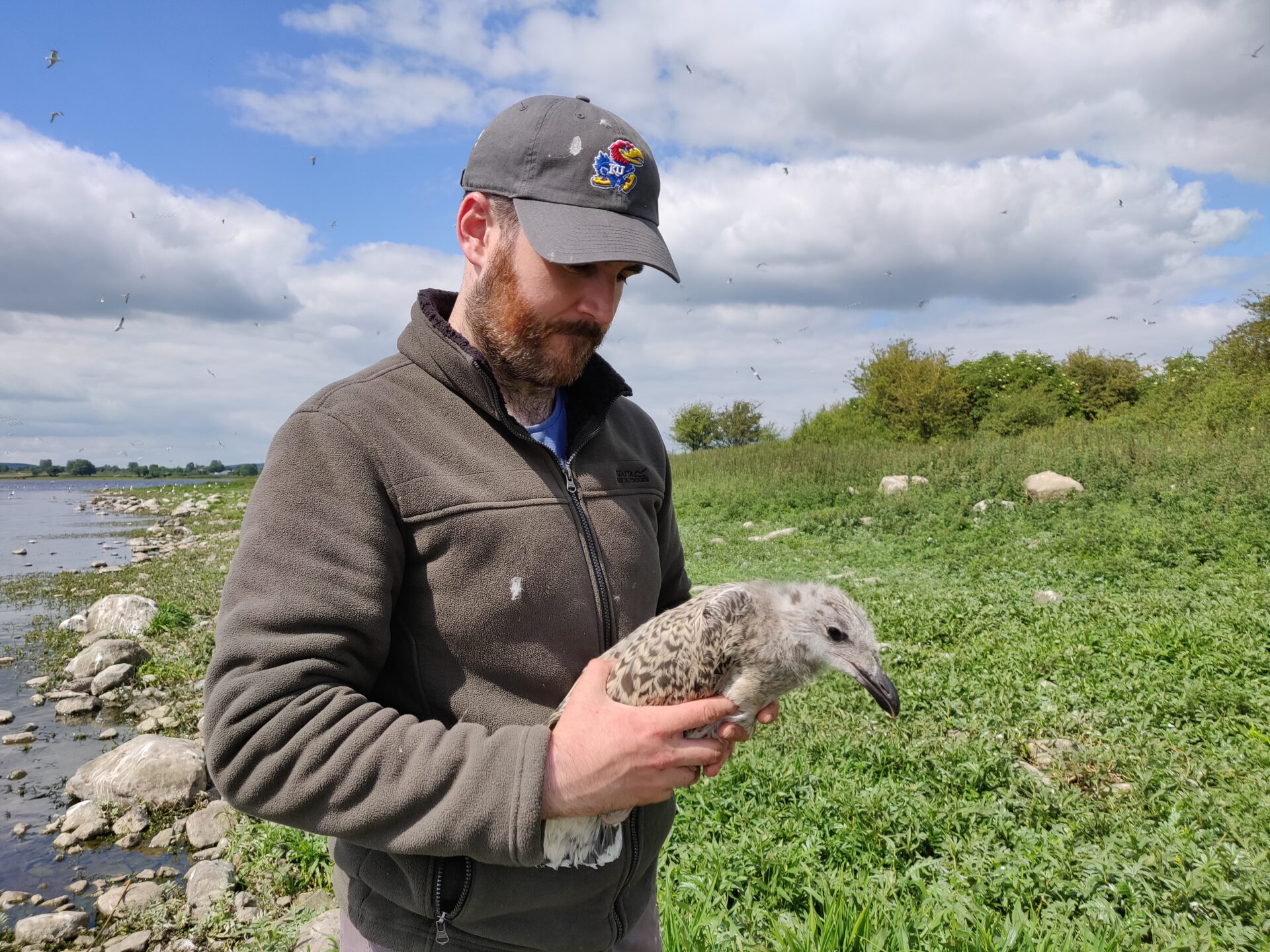
Q & A with Brian Burke - Project Manager of the Little Tern Project in Kilcoole
Marine Policy Officer, Rosalind Skillen, speaks to Little Tern Project Manager, Brian Burke about the The Little Tern Conservation Project in Kilcoole.
This is a National Parks and Wildlife Service project which is managed by Birdwatch Ireland. It is by far the largest Little Tern colony in Ireland, having grown from under fewer than 20 nesting pairs in the 1980s to 274 pairs in 2024.
Can you tell us a bit about Little Terns, the species you work to protect?
Little Terns are fantastic little birds. They weigh around 50g, so around half the size of a Blackbird. Terns were historically known as ‘sea swallows’ as they have a shape similar to a Swallow, with long pointed wings and forked tails, but are white and ‘marine’ in nature like a gull. These tiny little birds migrate to West Africa in the winter, and return to a number of out-of-the-way sand and shingle beaches around the Irish coast to try and raise their young. As seabirds that rely on a diet of fish, they’re excellent ecosystem indicators to give us an idea of what goes on beneath the waves. If Little Terns are doing well and raising young successfully, it must mean that the sea around their colony has enough fish to support them.
 Have you noticed any changes in populations or behaviours over the years?
The biggest change has been the numbers at the Kilcoole colony. We now have by far the biggest colony of Little Terns in Ireland, and one of the biggest in all of Ireland and the UK, and that’s thanks to many years of conservation efforts by the National Parks and Wildlife Service and BirdWatch Ireland. I think it’s a real testament to long-term funding and long-term efforts. Sometimes it can take a few years for your efforts to be rewarded, but when it comes to scarce and declining species, we need to stick with it. We still have occasional bad years at Kilcoole, but importantly we now have many more good years than bad and the Kilcoole and east coast population as a whole are growing.
Have you noticed any changes in populations or behaviours over the years?
The biggest change has been the numbers at the Kilcoole colony. We now have by far the biggest colony of Little Terns in Ireland, and one of the biggest in all of Ireland and the UK, and that’s thanks to many years of conservation efforts by the National Parks and Wildlife Service and BirdWatch Ireland. I think it’s a real testament to long-term funding and long-term efforts. Sometimes it can take a few years for your efforts to be rewarded, but when it comes to scarce and declining species, we need to stick with it. We still have occasional bad years at Kilcoole, but importantly we now have many more good years than bad and the Kilcoole and east coast population as a whole are growing.
 How do you involve the local community at Kilcoole?
The local community in Kilcoole are fantastic every year. They’re always delighted to see the Terns back, and indeed are sometimes concerned towards the end of April when we haven’t got all our fencing up yet! Something as simple as people walking on the beach, and letting dogs off leashes, are some of the biggest threats to Little Terns but everyone at Kilcoole is very happy to steer clear of the nesting area once the terns are back, and that makes a big difference. There’s a real sense of pride in Kilcoole around having these birds pick here to nest, and there’s a ‘Little Tern Playground’ in Kilcoole and one of the schools even has terns on their crest! Ultimately, many conservation problems are people problems rather than ecological problems. We know what most species need to thrive, but we need public buy-in to actually provide it. Thankfully the local community at Kilcoole are incredibly supportive.
How do you involve the local community at Kilcoole?
The local community in Kilcoole are fantastic every year. They’re always delighted to see the Terns back, and indeed are sometimes concerned towards the end of April when we haven’t got all our fencing up yet! Something as simple as people walking on the beach, and letting dogs off leashes, are some of the biggest threats to Little Terns but everyone at Kilcoole is very happy to steer clear of the nesting area once the terns are back, and that makes a big difference. There’s a real sense of pride in Kilcoole around having these birds pick here to nest, and there’s a ‘Little Tern Playground’ in Kilcoole and one of the schools even has terns on their crest! Ultimately, many conservation problems are people problems rather than ecological problems. We know what most species need to thrive, but we need public buy-in to actually provide it. Thankfully the local community at Kilcoole are incredibly supportive.
 What are the biggest threats to Little Terns in Kilcoole?
The biggest threats are predators, and waves. A single fox, or a determined Hooded Crow, Rook or Mink, could do a huge amount of damage in a very short space of time to a colony like this. Unfortunately in recent decades we’ve made the Irish landscape perfect for ‘mesopredators’ like these, and much less suitable for specialist species like the Little Tern. So we try and restore that balance on the beach at Kilcoole to give the Terns a chance. Similarly though, windy days, combined with a high tide can spell disaster for the colony and we’ve had huge amounts of eggs and chicks washed away in a couple of hours. Unfortunately there’s nothing you can do to stop the sea swell when conditions are like that, and with climate change and stormier and more unpredictable weather each summer it's something we’re going to keep seeing in the years ahead.
What are the biggest threats to Little Terns in Kilcoole?
The biggest threats are predators, and waves. A single fox, or a determined Hooded Crow, Rook or Mink, could do a huge amount of damage in a very short space of time to a colony like this. Unfortunately in recent decades we’ve made the Irish landscape perfect for ‘mesopredators’ like these, and much less suitable for specialist species like the Little Tern. So we try and restore that balance on the beach at Kilcoole to give the Terns a chance. Similarly though, windy days, combined with a high tide can spell disaster for the colony and we’ve had huge amounts of eggs and chicks washed away in a couple of hours. Unfortunately there’s nothing you can do to stop the sea swell when conditions are like that, and with climate change and stormier and more unpredictable weather each summer it's something we’re going to keep seeing in the years ahead.
 What can we do to support your work?
I think the Kilcoole Little Tern conservation project is a fantastic example of what can be achieved with long-term funding and continued efforts to address conservation problems and develop expertise over time. Kilcoole wasn’t an immediate success, but over time we’ve worked closely with NPWS to address the issues the birds face and to get to the stage where we have more good years than bad years. I think we need more protected sites, offshore and onshore, and we need to get plans and resources in place to reverse the biodiversity declines that are happening. Monitoring is important too – we need to know what we have, where we have it, and how it’s changing over time. The only way we’ll know if protection and conservation efforts are working is with continued monitoring. And importantly, we need to start now – there’s no time to waste!
[Photos 1-3: Brian Burke; Photo 4 (Ringing Photo): Oonagh Duggan]
The Kilcoole Little Tern Project is an NPWS project run by BirdWatch Ireland under a competitive tender agreement in 2024.
What can we do to support your work?
I think the Kilcoole Little Tern conservation project is a fantastic example of what can be achieved with long-term funding and continued efforts to address conservation problems and develop expertise over time. Kilcoole wasn’t an immediate success, but over time we’ve worked closely with NPWS to address the issues the birds face and to get to the stage where we have more good years than bad years. I think we need more protected sites, offshore and onshore, and we need to get plans and resources in place to reverse the biodiversity declines that are happening. Monitoring is important too – we need to know what we have, where we have it, and how it’s changing over time. The only way we’ll know if protection and conservation efforts are working is with continued monitoring. And importantly, we need to start now – there’s no time to waste!
[Photos 1-3: Brian Burke; Photo 4 (Ringing Photo): Oonagh Duggan]
The Kilcoole Little Tern Project is an NPWS project run by BirdWatch Ireland under a competitive tender agreement in 2024.


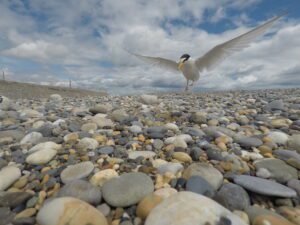 Have you noticed any changes in populations or behaviours over the years?
The biggest change has been the numbers at the Kilcoole colony. We now have by far the biggest colony of Little Terns in Ireland, and one of the biggest in all of Ireland and the UK, and that’s thanks to many years of conservation efforts by the National Parks and Wildlife Service and BirdWatch Ireland. I think it’s a real testament to long-term funding and long-term efforts. Sometimes it can take a few years for your efforts to be rewarded, but when it comes to scarce and declining species, we need to stick with it. We still have occasional bad years at Kilcoole, but importantly we now have many more good years than bad and the Kilcoole and east coast population as a whole are growing.
Have you noticed any changes in populations or behaviours over the years?
The biggest change has been the numbers at the Kilcoole colony. We now have by far the biggest colony of Little Terns in Ireland, and one of the biggest in all of Ireland and the UK, and that’s thanks to many years of conservation efforts by the National Parks and Wildlife Service and BirdWatch Ireland. I think it’s a real testament to long-term funding and long-term efforts. Sometimes it can take a few years for your efforts to be rewarded, but when it comes to scarce and declining species, we need to stick with it. We still have occasional bad years at Kilcoole, but importantly we now have many more good years than bad and the Kilcoole and east coast population as a whole are growing.
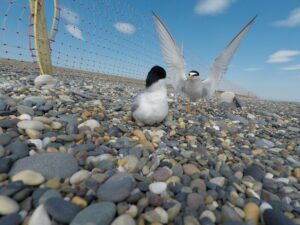 How do you involve the local community at Kilcoole?
The local community in Kilcoole are fantastic every year. They’re always delighted to see the Terns back, and indeed are sometimes concerned towards the end of April when we haven’t got all our fencing up yet! Something as simple as people walking on the beach, and letting dogs off leashes, are some of the biggest threats to Little Terns but everyone at Kilcoole is very happy to steer clear of the nesting area once the terns are back, and that makes a big difference. There’s a real sense of pride in Kilcoole around having these birds pick here to nest, and there’s a ‘Little Tern Playground’ in Kilcoole and one of the schools even has terns on their crest! Ultimately, many conservation problems are people problems rather than ecological problems. We know what most species need to thrive, but we need public buy-in to actually provide it. Thankfully the local community at Kilcoole are incredibly supportive.
How do you involve the local community at Kilcoole?
The local community in Kilcoole are fantastic every year. They’re always delighted to see the Terns back, and indeed are sometimes concerned towards the end of April when we haven’t got all our fencing up yet! Something as simple as people walking on the beach, and letting dogs off leashes, are some of the biggest threats to Little Terns but everyone at Kilcoole is very happy to steer clear of the nesting area once the terns are back, and that makes a big difference. There’s a real sense of pride in Kilcoole around having these birds pick here to nest, and there’s a ‘Little Tern Playground’ in Kilcoole and one of the schools even has terns on their crest! Ultimately, many conservation problems are people problems rather than ecological problems. We know what most species need to thrive, but we need public buy-in to actually provide it. Thankfully the local community at Kilcoole are incredibly supportive.
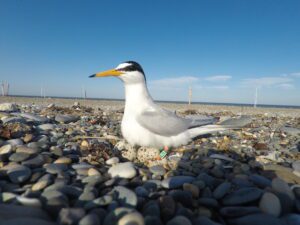 What are the biggest threats to Little Terns in Kilcoole?
The biggest threats are predators, and waves. A single fox, or a determined Hooded Crow, Rook or Mink, could do a huge amount of damage in a very short space of time to a colony like this. Unfortunately in recent decades we’ve made the Irish landscape perfect for ‘mesopredators’ like these, and much less suitable for specialist species like the Little Tern. So we try and restore that balance on the beach at Kilcoole to give the Terns a chance. Similarly though, windy days, combined with a high tide can spell disaster for the colony and we’ve had huge amounts of eggs and chicks washed away in a couple of hours. Unfortunately there’s nothing you can do to stop the sea swell when conditions are like that, and with climate change and stormier and more unpredictable weather each summer it's something we’re going to keep seeing in the years ahead.
What are the biggest threats to Little Terns in Kilcoole?
The biggest threats are predators, and waves. A single fox, or a determined Hooded Crow, Rook or Mink, could do a huge amount of damage in a very short space of time to a colony like this. Unfortunately in recent decades we’ve made the Irish landscape perfect for ‘mesopredators’ like these, and much less suitable for specialist species like the Little Tern. So we try and restore that balance on the beach at Kilcoole to give the Terns a chance. Similarly though, windy days, combined with a high tide can spell disaster for the colony and we’ve had huge amounts of eggs and chicks washed away in a couple of hours. Unfortunately there’s nothing you can do to stop the sea swell when conditions are like that, and with climate change and stormier and more unpredictable weather each summer it's something we’re going to keep seeing in the years ahead.
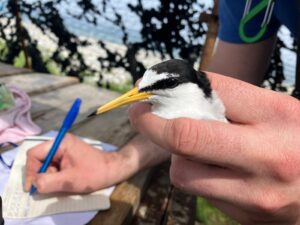 What can we do to support your work?
I think the Kilcoole Little Tern conservation project is a fantastic example of what can be achieved with long-term funding and continued efforts to address conservation problems and develop expertise over time. Kilcoole wasn’t an immediate success, but over time we’ve worked closely with NPWS to address the issues the birds face and to get to the stage where we have more good years than bad years. I think we need more protected sites, offshore and onshore, and we need to get plans and resources in place to reverse the biodiversity declines that are happening. Monitoring is important too – we need to know what we have, where we have it, and how it’s changing over time. The only way we’ll know if protection and conservation efforts are working is with continued monitoring. And importantly, we need to start now – there’s no time to waste!
[Photos 1-3: Brian Burke; Photo 4 (Ringing Photo): Oonagh Duggan]
The Kilcoole Little Tern Project is an NPWS project run by BirdWatch Ireland under a competitive tender agreement in 2024.
What can we do to support your work?
I think the Kilcoole Little Tern conservation project is a fantastic example of what can be achieved with long-term funding and continued efforts to address conservation problems and develop expertise over time. Kilcoole wasn’t an immediate success, but over time we’ve worked closely with NPWS to address the issues the birds face and to get to the stage where we have more good years than bad years. I think we need more protected sites, offshore and onshore, and we need to get plans and resources in place to reverse the biodiversity declines that are happening. Monitoring is important too – we need to know what we have, where we have it, and how it’s changing over time. The only way we’ll know if protection and conservation efforts are working is with continued monitoring. And importantly, we need to start now – there’s no time to waste!
[Photos 1-3: Brian Burke; Photo 4 (Ringing Photo): Oonagh Duggan]
The Kilcoole Little Tern Project is an NPWS project run by BirdWatch Ireland under a competitive tender agreement in 2024.

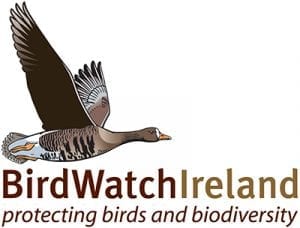
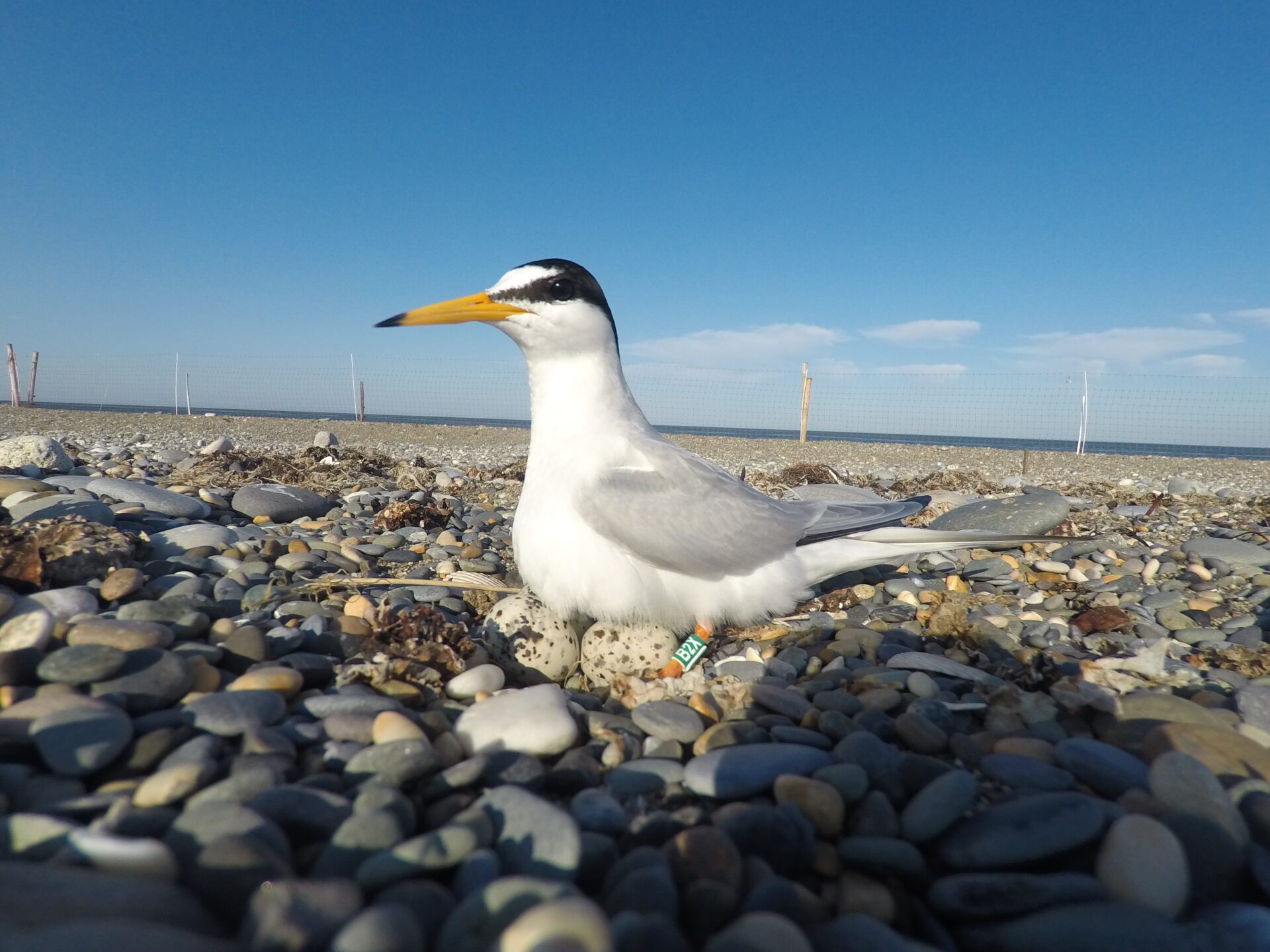
Highs and Lows for Kilcoole Little Terns in 2024
There is no doubt that turning the tide against biodiversity loss is an uphill battle but despite the worrying trends for many species, there is proof out there that we can halt and reverse declines. Indeed, well-resourced, science-based and longstanding conservation projects truly work, and the Kilcoole Little Tern Project is a shining example of this. It is a National Parks and Wildlife Service (NPWS) project, run by BirdWatch Ireland to date.
Of course, every season comes with surprises and 2024 was no exception. There is usually some predictability around the dates the Little Terns arrive back from Africa, and we aim to have the colony fencing and hide in place by the time the first eggs are being laid. The Terns had other plans this year though.
“The season kicked off surprisingly early. The first egg was discovered on the 9th of May. Usually, the 14th or 15th would be considered early so we were caught off guard, in a positive way. We were still in set-up mode at that stage,” explains Brian Burke, Coordinator of the Kilcoole Little Tern Project.
“When that happens, you have to be careful when setting up the fencing to not cause disturbance. We had to tailor what we were doing to ensure that we didn’t keep them off the nests for too long. Thankfully, everything went smoothly and chicks from all of those early nests hatched successfully.”

 It is difficult to pinpoint why some terns arrive early. However, it is likely influenced at least in part by the Kilcoole project itself.
“Kilcoole is a reliable and successful place for them to nest, not because there is anything particularly unique about the beach, but because of the project and the level of protection it has provided to the birds for many years,” says Brian. “The most experienced terns always start nesting first and, the more experienced terns you’ve had, the earlier the season begins.”
As the rate of new eggs being laid continued apace, it was quickly becoming clear that a very large number of Little Terns had returned to Kilcoole this year.
At its peak in early June we recorded over 270 nesting pairs of Little Terns at Kilcoole. This is the highest-ever number for the project and a long way from the 14 pairs recorded at the project’s onset many years ago. Based on these figures, Kilcoole likely had one of the largest Little Tern colonies in the Ireland and Britain this year and numbers from colonies monitored and protected by Louth Nature Trust at Baltray, BirdWatch Ireland Fingal Branch in Portrane, and NPWS in Cahore all suggest healthy nesting numbers at other key Irish sites.
It is difficult to pinpoint why some terns arrive early. However, it is likely influenced at least in part by the Kilcoole project itself.
“Kilcoole is a reliable and successful place for them to nest, not because there is anything particularly unique about the beach, but because of the project and the level of protection it has provided to the birds for many years,” says Brian. “The most experienced terns always start nesting first and, the more experienced terns you’ve had, the earlier the season begins.”
As the rate of new eggs being laid continued apace, it was quickly becoming clear that a very large number of Little Terns had returned to Kilcoole this year.
At its peak in early June we recorded over 270 nesting pairs of Little Terns at Kilcoole. This is the highest-ever number for the project and a long way from the 14 pairs recorded at the project’s onset many years ago. Based on these figures, Kilcoole likely had one of the largest Little Tern colonies in the Ireland and Britain this year and numbers from colonies monitored and protected by Louth Nature Trust at Baltray, BirdWatch Ireland Fingal Branch in Portrane, and NPWS in Cahore all suggest healthy nesting numbers at other key Irish sites.
 The 2024 season wasn’t all plain sailing, however.
“We had one week in June where the birds’ fortunes took a hit, unfortunately. There was some predation by Hooded Crows, who caused a lot of damage in a short space of time before the wardens could put a stop to it. A few days later, stormy weather and a sea swell at high tide took a lot of medium-sized chicks on the shoreline,” says Brian.
“If these impacts happened earlier in the season when most were still on their eggs, there would have been the time and opportunity for birds to relay. Unfortunately, because of the timing in mid-June, many of the birds were too late to try again. That was the low point of the season and the hard-hitting reality of this kind of work.”
Thankfully, things have been progressing very well since. Any subsequent predation incidents were minor and successfully managed by the colony wardens and a large number of chicks have now fledged. Some of them have already been spotted at the Little Tern conservation project at Portrane in north Dublin, and Gronant in Wales, as they explore the Irish Sea prior to migration.
The 2024 season wasn’t all plain sailing, however.
“We had one week in June where the birds’ fortunes took a hit, unfortunately. There was some predation by Hooded Crows, who caused a lot of damage in a short space of time before the wardens could put a stop to it. A few days later, stormy weather and a sea swell at high tide took a lot of medium-sized chicks on the shoreline,” says Brian.
“If these impacts happened earlier in the season when most were still on their eggs, there would have been the time and opportunity for birds to relay. Unfortunately, because of the timing in mid-June, many of the birds were too late to try again. That was the low point of the season and the hard-hitting reality of this kind of work.”
Thankfully, things have been progressing very well since. Any subsequent predation incidents were minor and successfully managed by the colony wardens and a large number of chicks have now fledged. Some of them have already been spotted at the Little Tern conservation project at Portrane in north Dublin, and Gronant in Wales, as they explore the Irish Sea prior to migration.

 The colony has also managed to escape Avian Influenza (Bird Flu) for another year. While the nesting habits of Little Terns make them less vulnerable to Avian Flu than those that nest in mixed species, high-density colonies such as Common Terns and Roseate Terns, the potential threat of the deadly disease is never far from our minds during the breeding season.
Most of the Kilcoole Little Terns have now left the site and the few remain will soon depart, leaving Brian and the wardens behind with reports to write and reflections on another busy season!
“The lesson this year is that every year is different. We are constantly trying to control what we can control but of course, some things are uncontrollable. Overall, it's about us giving the birds more good years than bad years,” says Brian.
[Nesting Little Tern Photos by Brian Burke, taken under NPWS licence]
The Kilcoole Little Tern Project is an NPWS project run by BirdWatch Ireland under a competitive tender agreement in 2024.
The colony has also managed to escape Avian Influenza (Bird Flu) for another year. While the nesting habits of Little Terns make them less vulnerable to Avian Flu than those that nest in mixed species, high-density colonies such as Common Terns and Roseate Terns, the potential threat of the deadly disease is never far from our minds during the breeding season.
Most of the Kilcoole Little Terns have now left the site and the few remain will soon depart, leaving Brian and the wardens behind with reports to write and reflections on another busy season!
“The lesson this year is that every year is different. We are constantly trying to control what we can control but of course, some things are uncontrollable. Overall, it's about us giving the birds more good years than bad years,” says Brian.
[Nesting Little Tern Photos by Brian Burke, taken under NPWS licence]
The Kilcoole Little Tern Project is an NPWS project run by BirdWatch Ireland under a competitive tender agreement in 2024.


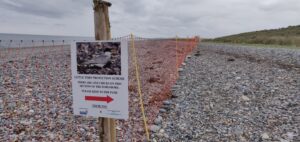
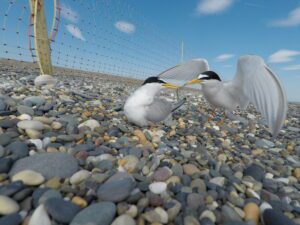 It is difficult to pinpoint why some terns arrive early. However, it is likely influenced at least in part by the Kilcoole project itself.
“Kilcoole is a reliable and successful place for them to nest, not because there is anything particularly unique about the beach, but because of the project and the level of protection it has provided to the birds for many years,” says Brian. “The most experienced terns always start nesting first and, the more experienced terns you’ve had, the earlier the season begins.”
As the rate of new eggs being laid continued apace, it was quickly becoming clear that a very large number of Little Terns had returned to Kilcoole this year.
At its peak in early June we recorded over 270 nesting pairs of Little Terns at Kilcoole. This is the highest-ever number for the project and a long way from the 14 pairs recorded at the project’s onset many years ago. Based on these figures, Kilcoole likely had one of the largest Little Tern colonies in the Ireland and Britain this year and numbers from colonies monitored and protected by Louth Nature Trust at Baltray, BirdWatch Ireland Fingal Branch in Portrane, and NPWS in Cahore all suggest healthy nesting numbers at other key Irish sites.
It is difficult to pinpoint why some terns arrive early. However, it is likely influenced at least in part by the Kilcoole project itself.
“Kilcoole is a reliable and successful place for them to nest, not because there is anything particularly unique about the beach, but because of the project and the level of protection it has provided to the birds for many years,” says Brian. “The most experienced terns always start nesting first and, the more experienced terns you’ve had, the earlier the season begins.”
As the rate of new eggs being laid continued apace, it was quickly becoming clear that a very large number of Little Terns had returned to Kilcoole this year.
At its peak in early June we recorded over 270 nesting pairs of Little Terns at Kilcoole. This is the highest-ever number for the project and a long way from the 14 pairs recorded at the project’s onset many years ago. Based on these figures, Kilcoole likely had one of the largest Little Tern colonies in the Ireland and Britain this year and numbers from colonies monitored and protected by Louth Nature Trust at Baltray, BirdWatch Ireland Fingal Branch in Portrane, and NPWS in Cahore all suggest healthy nesting numbers at other key Irish sites.
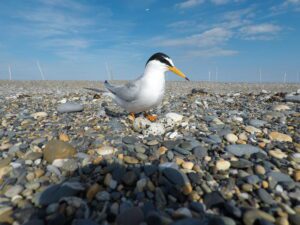 The 2024 season wasn’t all plain sailing, however.
“We had one week in June where the birds’ fortunes took a hit, unfortunately. There was some predation by Hooded Crows, who caused a lot of damage in a short space of time before the wardens could put a stop to it. A few days later, stormy weather and a sea swell at high tide took a lot of medium-sized chicks on the shoreline,” says Brian.
“If these impacts happened earlier in the season when most were still on their eggs, there would have been the time and opportunity for birds to relay. Unfortunately, because of the timing in mid-June, many of the birds were too late to try again. That was the low point of the season and the hard-hitting reality of this kind of work.”
Thankfully, things have been progressing very well since. Any subsequent predation incidents were minor and successfully managed by the colony wardens and a large number of chicks have now fledged. Some of them have already been spotted at the Little Tern conservation project at Portrane in north Dublin, and Gronant in Wales, as they explore the Irish Sea prior to migration.
The 2024 season wasn’t all plain sailing, however.
“We had one week in June where the birds’ fortunes took a hit, unfortunately. There was some predation by Hooded Crows, who caused a lot of damage in a short space of time before the wardens could put a stop to it. A few days later, stormy weather and a sea swell at high tide took a lot of medium-sized chicks on the shoreline,” says Brian.
“If these impacts happened earlier in the season when most were still on their eggs, there would have been the time and opportunity for birds to relay. Unfortunately, because of the timing in mid-June, many of the birds were too late to try again. That was the low point of the season and the hard-hitting reality of this kind of work.”
Thankfully, things have been progressing very well since. Any subsequent predation incidents were minor and successfully managed by the colony wardens and a large number of chicks have now fledged. Some of them have already been spotted at the Little Tern conservation project at Portrane in north Dublin, and Gronant in Wales, as they explore the Irish Sea prior to migration.
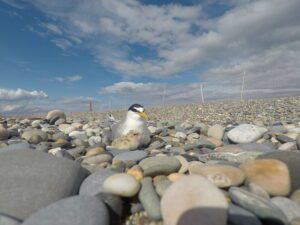
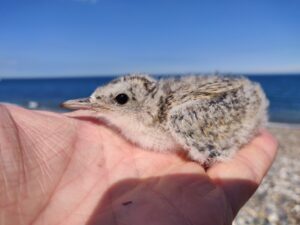 The colony has also managed to escape Avian Influenza (Bird Flu) for another year. While the nesting habits of Little Terns make them less vulnerable to Avian Flu than those that nest in mixed species, high-density colonies such as Common Terns and Roseate Terns, the potential threat of the deadly disease is never far from our minds during the breeding season.
Most of the Kilcoole Little Terns have now left the site and the few remain will soon depart, leaving Brian and the wardens behind with reports to write and reflections on another busy season!
“The lesson this year is that every year is different. We are constantly trying to control what we can control but of course, some things are uncontrollable. Overall, it's about us giving the birds more good years than bad years,” says Brian.
[Nesting Little Tern Photos by Brian Burke, taken under NPWS licence]
The Kilcoole Little Tern Project is an NPWS project run by BirdWatch Ireland under a competitive tender agreement in 2024.
The colony has also managed to escape Avian Influenza (Bird Flu) for another year. While the nesting habits of Little Terns make them less vulnerable to Avian Flu than those that nest in mixed species, high-density colonies such as Common Terns and Roseate Terns, the potential threat of the deadly disease is never far from our minds during the breeding season.
Most of the Kilcoole Little Terns have now left the site and the few remain will soon depart, leaving Brian and the wardens behind with reports to write and reflections on another busy season!
“The lesson this year is that every year is different. We are constantly trying to control what we can control but of course, some things are uncontrollable. Overall, it's about us giving the birds more good years than bad years,” says Brian.
[Nesting Little Tern Photos by Brian Burke, taken under NPWS licence]
The Kilcoole Little Tern Project is an NPWS project run by BirdWatch Ireland under a competitive tender agreement in 2024.


